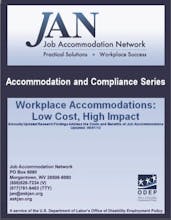Q
What is ERGONOMICS?
A
The word "ERGONOMICS" originates from the Greek words for work ("ergon") and law ("nomos"). Modern industrial ergonomics focuses on the study of work performance with an emphasis on worker safety, efficiency and productivity.
Q
Are Ergonomic Interventions Expensive?
A
NO! Ergonomics is not just about buying new equipment or making big changes to the worksite. Minimal expenditures for ergonomics can have a monumental benefit when it comes to injury prevention. Professional ergonomic consultation can save the company money and promote employee health and productivity. A healthy workforce creates a healthier bottom line.
Don’t believe the myths!
Look what Ergonomic interventions accomplish and save:


Small Ergonomic changes produce MAJOR benefits…
Contact ABILITYusa ergonomic consultants. They are available to come to your facility and assist with proper set up and training for injury prevention.
Ergonomics – Myths Busted!
-
MYTH: Ergonomics only has to do with posture for people who type all day.
FACT: It is essential that workstations and computers are set-up correctly for people who are typing all day, but ergonomics doesn’t only belong in the office. Ergonomics should be applied to EVERY job, no matter the setting (i.e., Healthcare, Production, Agriculture, etc.). It is just as important to apply ergonomic principles to those working at home and other physical tasks such as housekeeping, gardening, and home maintenance.
-
MYTH: Ergonomic evaluations are useless
FACT: Having an established ergonomics program will save money by reducing the injury rate, lowering workers’ compensation costs, increasing productivity, reducing turn-over and absenteeism, and improving morale and employee satisfaction.
In a case study by DeRango, et al involving 200 office employees it was determined that the benefit-to-cost ratio was nearly 25 times greater than the cost of the initial intervention.
-
MYTH: Ergonomic interventions/ modifications/ accommodations are costly.

FACT: Most employers report no cost or low cost for accommodating employees with disabilities. (JAN)
- 58% of accommodations were made at no cost
- 37% of accommodations required a one-time cost per employee with a typical cost of $500
- Results: Making small changes can allow employers to keep qualified employees while increasing productivity and improving attendance.
-
MYTH: Ergonomics is a marketing term used by furniture companies to sell expensive products.
FACT: Ergonomics is far more than a marketing “buzzword”. It is an interdisciplinary science dedicated to improving quality of life and work in terms of how we utilize and interact with technology and the environment around us.
Implement Ergonomic Assessments to Prevent Injuries
Office Myths
-

MYTH: All people have the same ergonomic furniture needs.
FACT: Ergonomics is not a one size fits all solution. This is the most important principle for the application of ergonomic interventions.
Just because a mouse, a chair, a keyboard, etc. works for one person it does not mean that it will work for everyone. Before making any purchases, each person needs to be assessed and evaluated for their specific ergonomic needs. You may find that many people will need little to no equipment, just education on basic ergonomic principles to reduce the risk of RSI (Repetitive Strain Injuries) or injuries from static postures.
At shared workstations it is essential for each employee to be responsible to adjust the equipment for their unique physical attributes (anthropomorphic).
-
MYTH: I have an Ergonomic Workstation, so I can work with changing postures for 8 hours straight.
FACT: Static postures or static loading can place increased loads on muscles or forces on muscles and tendons, which contribute to fatigue.
Tasks requiring employees to maintain the same position for an extended period increase the static loads/forces on muscles and other tissues. The longer postures must be maintained, the greater the loading of muscles and other tissues. This increased force contributes to fatigue and muscle-tendon strain.
Exposure to contact stress may be a by-product of prolonged static loading. When muscles become fatigued, employees look for ways to rest the affected areas. Sometimes employees may rest their arms or wrists on the hard surface and edges of the workstation. For example, computer operators may relieve static loading on their forearms and wrists by resting their wrists on the edge of the computer table. However, the blood flow and movement of their wrists may continue to be reduced because of the contact stress.
Manufacturing Myths
-
MYTH: Ergonomics has NO effect on Productivity
FACT: When you reduce ergonomic risk factors and the interaction between the work and the worker is improved, productivity increases. Productivity can be improved by:
- Reducing awkward postures
- Reducing high force requirements
- Reducing highly repetitive tasks
- Increasing frequency of duty rotation
- Increasing frequency of microbreaks, applicable muscle group stretches, and motion release activities
Agriculture Myths
-

MYTH: There are no needs for Ergonomic considerations with agriculture work.
FACT: Agriculture work has become more mechanized over the last 100 years, but many tasks and activities are still performed by hand. These tasks require stooping, bending, lifting, twisting, kneeling, forceful gripping; carrying, vibrating equipment/machinery and long periods of repetitive motion can all lead to musculoskeletal injuries.
Driving Myths - Car/Truck:
-

MYTH: It does not matter how I sit in the car to drive.
FACT: There are significant associations between driving and back problems.
On average, men drive 44 miles per day; women drive 34 miles per day.
How you sit in the car/truck and where you place your hands on the steering wheel are not the only factors of Vehicle Ergonomics.
-
MYTH: I can get out of the car after a long drive and perform heavy tasks without any increased risk for injury.
FACT: There is an increased risk of low back injury when lifting immediately after driving for longer periods (more than 19 miles).
The professions and trades listed below are at an increased risk of low back injury when lifting immediately after driving:
- Truck Drivers
- Ambulance Drivers
- Bus Drivers
- Forklift Operators
- Farmers
- Delivery / Courier Service Workers
- Taxi / Limousine Drivers
- Travelling Sales / Route Sales Workers
- Law Enforcement
- Pilots
Important Injury Prevention Training should include the relevant prevention measures applicable to minimizing injury potential in each specific industry.ABILITYusa clinicians can assist with this training.
Reduce risks using individualized training,: job specific stretch/motion/release techniques and applied ergonomic principles.


